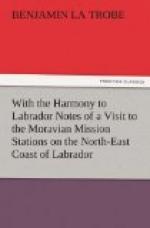Let us continue our visits to the inhabited houses, one next the other, in an irregular row. Outside them the children are playing about and seem to enjoy life. Here and there one may see a sledge, or a kayak, the skin-covered boat such as is used, by the men. The larger umiak, or women’s boat, is now scarcely met with in Labrador. There are one or two light wooden skeleton frames of kayaks, but most are tightly covered with white smooth skins, cleverly sewn together by the women. Look at this one lying on the grass; it is about fifteen feet long, but you can lift the end of it quite easily. The owner paddled home in it this morning from his fishing-place at the head of the fjord, and sold fifty-two trout off the top of it to the captain, as he passed the “Harmony.” His bone-pointed harpoon and a hook with a long handle are strapped on top of the canoe. Beside it lies his paddle, which the Eskimo wields so deftly and silently that even a seal may fail to detect his swift approach. Its blades at both ends are beautifully finished off with bone. I see his gun is carelessly left in the round man-hole in which he sits when afloat. It may be loaded; I hope the children will let it alone.
Passing Daniel’s empty hut, for he and his family are away fishing, we call on Ikkaujak and Sakkearak (now John and Ernestine), and then on Matthew and his wife Verona, who not long ago were known as Swanzi and Akkusane. Matthew is interested to show and explain the weapons of the chase. His racket-shaped snow-shoes are the shortest I ever saw. Longer ones, unless like the Norwegian skydder, would be unpractical among these mountains. His harpoons hang on the wall next his gun. The blunt one, pointed with a walrus tooth, is used in the body of a seal, but the iron-pointed one is needed when the animal’s head alone is above the water or the ice. Both are cleverly put together with wood, bone, and thongs, so arranged that when necessary head and haft easily come apart.
Some of these Ramah Eskimoes are perhaps 5 ft. 10 in. in height, and most of them look robust and strong; but little Paul’s door is very low, and I must bend double to enter his hut. His heathen name was Simigak and his wife’s Ikkinek when they came from Nachvak in 1881. He is not at home, but his Adolfine gives us a welcome in Eskimo fashion. There is a stove in the corner, and on it a pot with some pieces of salmon in it. A few trout are strung up to the roof. I notice a clock in the corner, but am told that it is broken. Perhaps Paul can mend it; at any rate, while I was at Hopedale some Newfoundland fishermen entrusted their ship clock to an Eskimo for repairs.
The last hut in the village is Frederick’s. Some of his goods are here, but most are in the tent where we found his wife and family. A few pictures are pasted on his walls. Many houses at other stations are almost papered with pages from the Graphic and Illustrated London News.




